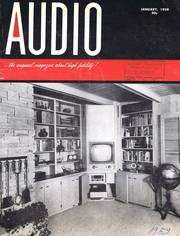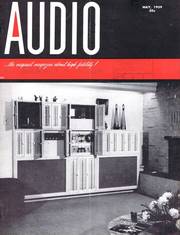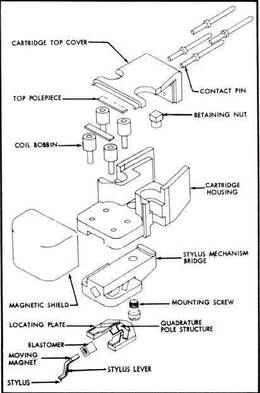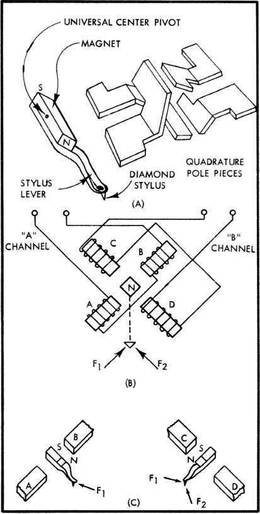Erläuterungen zu diesen US-AUDIO Seiten der 1950er Jahre
Die hier stehenden amerikanischen Artikel aus 1959 (aus der US-AUDIO) sind teilweise sehr gewöhnungsbedürftig, weil sie erstens aus einer längst vergangenen Zeit stammen und zweitens, weil dort in den USA ganz "anders" gedacht wurde als bei uns in Old Germany oder in Europa.
Vergleichbar mit unseren deutschen Hifi-Magazinen etwa ab 1962 ist jedoch, daß auch dieses Audio-Magazin ihre Anzeigen- Kunden und -Leser am Markt oder von anderen Magazinen (be- oder ab- ?) werben mußte. - Weiterhin sind die riesigen Dimensionen des amerikanischen Kontinents mit unseren hier in Europa nicht vergleichbar. - Ein Redaktions-"Trip" von New York nach Los Angeles oder Chicago oder gar in die Wüste nach Las-Vegas zu einer der CES- Audio- "Shows" war - auch mit dem Flugzeug - immer noch eine halbe Weltreise. Und jede Ausstellung oder "Messe" wurde als "Show" deklariert. Und natürlich, in USA musste alles "Show" sein, um beim Publikum einige Aufmerksamkeit zu erzeugen.
von Gert Redlich im Sommer 2020 - Mir ist bewußt, daß dieser Technik-Artikel recht komplex ist und auch schon wegen der Sprache ist er nicht so leicht verständlich. Doch es ist - so glaube ich - unbedingt wissenswert, daß auch die amerikanischen Audio-Ingenieure (ähnich wie unser Georg Neumann in Berlin) bereits 1959 recht genau wußten, womit sie sich da beschäftigen und auf welch dünnem Eis das ganze gebacken war. Sie müssen also die ganzen Formeln im Text nicht verstehen. Blättern Sie einfach mal drüber.
.
.
Moving-Magnetic Stereo - ein Artikel aus US-AUDIO May 1959
"The new horizon of stereo disc reproduction" (ab Seite 19)
A discussion of the design features of the newest stereo pickup to reach the market with an analysis of some of the parameters which affect performance.
von HERBERT HOROWITZ - Er ist "Director of Commercial Products" der Firma Audio-Empire Division, Dyna-Empire, Inc., 1075 Stewart Ave., Garden City, N. Y.
.
Ein Schritt weiter auf dem Weg zu neuen Zielen
From the slow first steps towards new goals, our scientific and engineering progress creates and accelerates further progress.
With stereo disc reproduction, as in all new moves forward, there have been inadequacies ranging from crude initial disc-cutting equipment to doctored and modified monophonic phono pickups attempting to make use of the new stereo media.
The design problems of recording cutters and playback pickups have been the major technical bottleneck to public acceptance and appreciation of the new stereo technique.
.
Neue Schneidsysteme für Stereo-Platten seit letztem Jahr
New and improved stereo cutters have emerged (entwickelt) during the past year (1958), and new design approaches and principles have been applied to produce high-quality stereophonic phonograph pickups to equal and surpass the standards of excellence achieved during the mono-phonic era.
Initial attempts at stereo pickups followed the basic established patterns of ceramic, variable-reluctance, and moving-coil technical design.
All of these attempts bottlenecked in the miasma of high cost, high moving mass, difficult construction, high distortion, and so on.
Any new principle of technology must move by necessity to newer principles of technique.
Designers of stereo pickups who were able to visualize the complex problems began to approach the solution from a new direction.
This approach has now been formulated to the major breakthrough needed to give the final impetus to the bandwagon of stereo disc reproduction.
.
- Anmerkung : Der Autor schreibt nichts über das Patent der deutschen Firma ELAC für den bewegten magneten (moving magnet), mit dem der Wettbewerber SHURE als Lizenznehmer gigantische weltweite Erfolge bis zur Marktführerschaft erzielt hatte.
.
Moving-Magnet System
This new concept is the "Moving-Magnet System." Phonograph pickup designers worked along this approach at the tail end of the monophonic era.
Although the basic principles date back quite a while, it has only been the major technological advances in magnetic materials of the last few years that allowed the system to be feasible.
Widespread fame eluded (ausweichen, umgehen) the moving-magnet monophonic pickup since it had to contend with the giants of variable reluctance and moving coil. Every new concept must have a raison d'etre. For the moving magnet it is Stereo.
Es ist das Gegenteil vom "Moving Coil" System
The moving-magnet system is the reverse application of the moving-coil system. The generating magnetic element produces a variable flux which induces electrical energy into stationary coils. The parameter of low distortion is basic in the moving-coil system and is therefore true of its converse, the moving magnet.The operation of this system can best be illustrated with Fig. 2.
At (A) is shown the basic magnet structure, a rod magnet of rectangular cross section magnetized lengthwise and inserted into the coil structure shown at (B) and pivoted at its center.
Coils A and B in hum-bucking series opposition form one coil structure which develops voltage from inner groove wall modulation while hum-bucked coils C and D develop the outer groove wall signal.
Force F1 as shown in (C) rotates the poles of the magnet toward and away from the pole faces of coils A and B creating a variable flux in the coil structure. However, force Fj has not caused any air gap variation relative to poles C and D since the magnet is moving parallel to those pole faces, and therefore there is no voltage generated in the C and D combination. Conversely force F2 causes a flux variation in the C and D structure while isolating A and B.
It is not possible to locate coils A and D beneath the magnet physically because of the practicality of stylus lever length.
.
Das "moving magnet pickup" von Audio-Empire
The Audio-Empire moving magnet pickup contains four vertical poles which mount coils as seen in Fig. 1. These vertical poles are mated wTith a quadrature pole structure, (A) in Fig. 2, designed to develop independent outputs from Ft and F2 modes of motion.
The quadrature pole structure is moulded into an independent structure; the magnet-and-stylus-lever assembly is inserted and mounted to its pivot. This allows simple stylus replacement by the complete removal of the moving-magnet mechanism.
Why the Superiority of the Moving-Magnet System ?
The technically minded audiofan has become familiar with the terms dynamic mass, compliance, frequency response, and resonance. These key parameters of phonograph pickup design are dependent upon one another for the over-all performance of the stereo pickup with its need for channel isolation.
Mechanical elements in motion have inertial effects which cause them to have inherent mechanical resonance at a frequency dependent upon the dynamic masses and compliances of the system.
Figure 3 shows the physical, mechanical, and electrical equivalent configurations of a typical arm and cartridge. The arm contains mass Ma and compliance Ca; the stylus mass is M8 and stylus compliance C8, while Cd is designated as the compliance of the disc under the proscribed stylus force.
Since C8 is much greater than Cd, and Ma greater than M8, we find that at very low audio frequencies the stylus mass M8 has virtually zero impedance and the record disc has a very small compliance. This leaves the mass of the arm Ma and the compliance of the stylus C8 as the determining factors of low-frequency resonance.
At the upper end of the frequency spectrum, the mass of the arm Ma attains too high an impedance to be moved by the system while the high compliance of the pickup C8 has virtually zero impedance.
We can say, therefore, that for high frequencies which indicates that the high-frequency resonance of the system is determined by the dynamic mass of the pickup and the compliance of the record disc.
Parameters of System Dynamic Mass
Any basic element turning about a pivot has inherent inertia which is reflected to the stylus tip. Let us examine a typical system, (A) in Fig. 4, where a mass is forced to pivot about axis AA. The inertia of the moving element about axis AA is given by:
(a lot of formulas and calculations - but to comlex)
The significance of these calculations lies in the factor h7. This indicates that in the determination of the effective mass of the system reflected to the stylus, the h factor is overwhelmingly the major element.
Variable-reluctance systems whose mass is uniformly distributed over a long lever are unable to achieve low mass because of large h factor.
It is obviously necessary to keep the mass of the system concentrated as close to the pivot center as possible. Figure 5 numerically and more pointedly demonstrates the relationship of dimension to dynamic mass reflected to the stylus tip. The three moving-element systems shown have cross sections which are identical yet they differ in the h dimension. Figure 5 shows the relative differences these systems exhibit in the parameters of weight, radius of gyration, and mass reflected to the stylus tip.
Eine obere und untere Resonanzfrequenz
All phonograph reproducing systems exhibit mechanical resonance at both upper and lower end of the spectrum. A frequency response pattern of a high-quality monophonic system is shown in Fig. 5.
Low-frequency resonance occurs at 12 cps while upper resonance occurs at 18,000 cps. The resonant frequency of the undamped system effectively extends over the full audible range from 16 cps to 15,000 cps within ±3db limits of amplitude.
.
Eine Dämpfung bewirkt eine flache Frequenzkurve
Introduction of damping to the cartridge system deflates the high-frequency resonant peak. Damping - which is amplitude sensitive in character but not velocity sensitive - is a distortion-generating factor and this is especially true of transient response where the RC time constant of a damped system does not allow for sufficiently rapid recovery time to insure faithful reproduction of musical content.
The effect of mass loading, operating in several degrees of freedom in mechanical resonance, is a major concern in stereo pickups because of its effect on channel separation.
Figure 7 compares the channel separations of a typical high-mass system with that of an inherently low-inertia moving-magnet pickup. The high-mass system at (A) shows a high-frequency mechanical resonance in the order of 11,000 cps.
This pickup is heavily damped to suppress audible amplitude effects of this resonance. Note the gradual loss of channel separation as we approach resonance with the complete loss at 12,000 cps and beyond in the high-mass system.
The moving magnet system shown in (B) can retain adequate channel separation throughout the ciudibit; range. Obviuusly as resunaiice is approached, the generating element mode of motion is no longer controlled by groove-wall modulation but becomes a function of natural resonant vibration.
Das Ergebnis sind aber Verzerrungen (high distortion)
Introduction of damping with its undesirable incorrect resistance character is the cause of the high distortion content encountered in many stereo pickups currently marketed. Pickup inefficiencies of this nature can no longer be attributed to poor cutterhead design.
The ideal cartridge mechanism is a virtually undamped system whose dynamic mass is so small that the natural resonance of the system lies outside the audible range and allows for flat frequency response and adequate channel separation.
Dynamic Mass of the Stylus
The Cd factor, compliance of the disc, has been relatively standardized and is a function of disc fabrication techniques and materials.
The only variable parameter of cartridge design capable of affecting high-frequency resonance becomes the dynamic mass of the system. The smaller the dynamic mass, the higher the point of resonance.
To calculate the dynamic mass of the moving-magnet system, previously
shown in Fig. 4, let us examine its three major components, stylus, stylus lever, and generating element.
The mass of the diamond illustrated ist given bey density.
With the density of diamond at 3.5 gms/cm3 we find for the nude stylus of .012" diameter and .030" long the actual stylus mass is 0.2(10)-3 grams or 0.2 milligrams. The stylus lever, made of aluminum .005" thick is negligible in mass.
The mass of the rectangular generating element pivoting about its center axis (AA) is concentrated at its radios of gyration.
The effective mass of the moving element referred to the stylus tip is given by the expression :
Effective Dynamic Mass = Mass of the Moving element x radius of gyration "divided by" distance from pivot center to stylus
For the case of the Empire "88" pickup shown, X = 0.2". In this pickup, to achieve an effective dynamic mass of the magnet referred to the stylus tip of 0.5(10)-3 grams, we find the maximum electromagnetic sensitivity of the system occurs when the moving magnet is made of "Alnico V" and its dimensions are .040" x .040" x .100" long. The total dynamic mass of the system is calculated to be = 0.7mg.
These dimensions allow from frequency characteristics surpassing those shown in Fig. 6. Thus the overwhelming strength of the moving magnet system, and the ability to use a moving element of very small dimension - thereby minimizing the effect of the h factor on radius of gyration and weight and allowing for extremely low dynamic mass reflected to the stylus tip - will produce relatively high output with coils of moderate impedance.
Superiority of Moving System
The moving-magnet stereo pickup system inherently allows for low-cost production and replaceable stylus assembly (long the problem of moving-coil systems).
The system is rugged yet fully compliant, virtually indestructible, and with no service problems of delicate rubber bearings and fragile moving coils.
The very small magnetic flux densities required are fully shielded and offer no magnetic attraction to steel turntables. Hum-bucking construction and magnetic shielding prevent pickup of motor and transformer field radiation and there is no audible hum produced in the system. This coupled with high output creates a pickup of outstanding signal to noise ratio.
The moving-magnet stereo system has become the prime mover of stereo disc reproduction. With its arrival, stereo has arrived, and will not take a back seat to any other method of sound reproduction. We can now look forward to future growth, expanded repertoire, and greater appreciation of musical and sound experiences.
.
- Anmerkung : Das waren also die "Standard Sprüche" des Verkäufers, vor allem zukünftiges Wachstum (der eigenen Firma) und erweiterte Produktvielfalt usw.
.
Bildunterschriften
Fig. 3. (A) Typical pickup-arm system, (B) its mechanical equivalent, and (C) its electrical equivalent.
Fig. 4. Diagram of stylus bar to determine moment of inertia.
Fig. 5. Table of parameters pertaining to stylus assemblies of different designs.
Fig. 6. Response of professional type monophonic pickup, corrected for equipment response and record deviation.
Fig. 7. Channel separation for Typical variable-reluctance pickup (A), and for moving-magnet pickup described (B).






